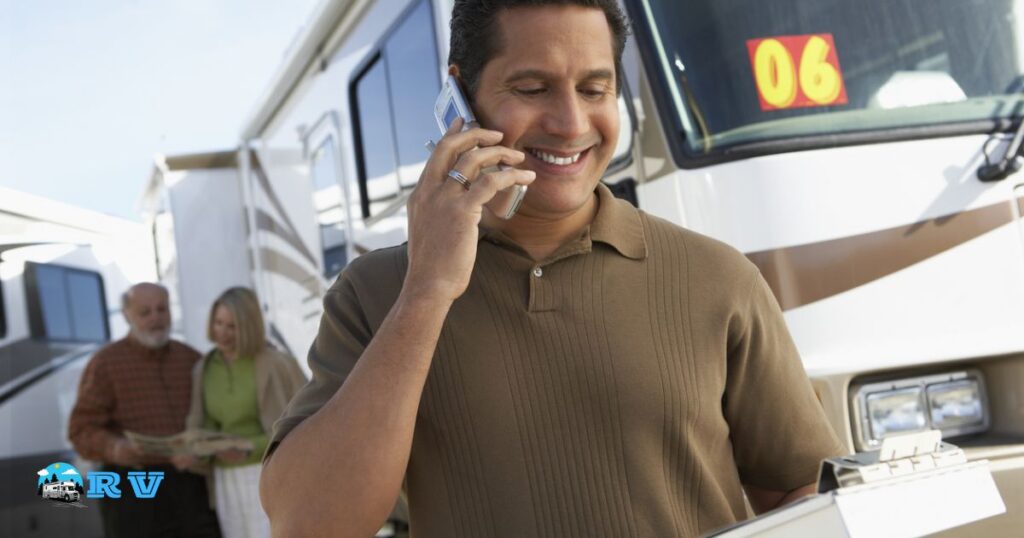Selling an RV with a loan refers to the process of transferring ownership of a recreational vehicle that has an outstanding loan balance. In this scenario, the seller still owes money to a lender, and they must navigate the sale while considering the existing loan.
If you’ve ever wondered, How to sell an RV with a loan? you’re not alone. This question often arises when RV owners decide to part ways with their vehicles but are still making payments. Selling an RV with a loan can be a complex undertaking, but with the right information and approach, it’s entirely manageable.
When selling an RV with a loan, it’s crucial to understand the loan terms, the remaining balance, and how to handle the financial aspects of the transaction. Additionally, you’ll need to navigate the logistics of transferring ownership and ensuring that the new owner assumes responsibility for the loan or secures their own financing..
Assessing Your RV Loan
Before you begin the process of selling your RV, it’s essential to have a clear understanding of your current loan situation. Assessing your RV loan involves several crucial steps.
Reviewing your loan agreement
Start by thoroughly reviewing your RV loan agreement. You’ll want to familiarize yourself with the terms, interest rates, and any specific clauses that pertain to selling the RV before the loan is paid off. This information will be crucial as you move forward with the sale.
Determining the outstanding balance
Next, determine the outstanding balance on your RV loan. This is the amount you still owe to the lender. This balance will impact the final sale price and the financial aspects of the transaction, so accurate calculations are essential.
Contacting the lender for details
Reach out to your lender to get all the necessary details about your RV loan. Your lender can provide you with the exact payoff amount, any applicable prepayment penalties, and instructions on how to handle the sale with an outstanding loan. Communication with the lender is key to a smooth process.
Implications of selling with an outstanding loan
It’s important to understand the implications of selling your RV with a loan balance. You’ll need to decide whether you’ll pay off the loan before the sale or if the buyer will assume the loan. Each option has its own considerations, including financial and legal aspects that need to be addressed.
Preparing Your RV for Sale

Once you’ve gathered all the necessary information about your loan, it’s time to prepare your RV for sale. Ensuring your RV is in the best possible condition and having all the required documentation ready is crucial.
Ensuring the RV is in good condition
Buyers are more likely to be interested in an RV that’s in good shape. Before listing your RV for sale, thoroughly clean and inspect it. Address any necessary maintenance or repairs to make the RV as attractive as possible to potential buyers.
Gathering all necessary documentation
Having all the necessary paperwork in order is essential for a smooth sale. Create a folder with documents such as the RV title, maintenance records, and any warranties that may be transferable. These documents will help instill confidence in potential buyers.
Setting a fair asking price
Determining the right asking price for your RV is critical. Research the market to see what similar RVs are selling for and consider the RV’s age, condition, and any unique features. You’ll want to strike a balance between getting a fair price and attracting potential buyers.
Marketing your RV effectively
To reach a wider audience of potential buyers, you need to market your RV effectively. Utilize online platforms, classified ads, and social media to create appealing listings with high-quality photos. Be honest and detailed in your descriptions to attract serious buyers.
Communicating with Potential Buyers
Once you’ve prepared your RV and started advertising, you’ll begin to receive inquiries from potential buyers. Communication is key during this phase, especially when your RV has an outstanding loan.
Disclosing the loan situation to buyers
When you communicate with potential buyers, it’s crucial to disclose the loan situation. Be transparent about the fact that there is an outstanding loan on the RV and explain the options available to the buyer, whether they assume the loan or secure their own financing.
Explaining the benefits of assuming the loan
If you’re open to having the buyer assume the loan, explain the benefits of this option. It can potentially save the buyer money on interest rates, and the process might be more straightforward than securing a new loan. Be ready to provide information about the loan terms and payments.
Negotiating the sale price
Negotiating the sale price can be one of the more challenging aspects of selling an RV with a loan. Be prepared for negotiations and be willing to compromise within reason. Keep in mind that the outstanding loan balance may limit how much you can lower the price.
Handling the Sale
Once you’ve found a willing buyer and agreed on the terms, it’s time to handle the sale itself. This involves several critical steps to ensure a smooth and secure transaction.
Drafting a secure bill of sale
A bill of sale is a legal document that outlines the terms of the sale and transfers ownership of the RV to the buyer. Ensure that the bill of sale is complete and accurately reflects the agreed-upon terms. It’s a good idea to consult with a legal expert or use a template to create this document.
Transferring ownership
Transferring ownership of the RV is a necessary step in the sale process. This typically involves signing over the title to the buyer and ensuring that all required paperwork is completed accurately.
Escrow services and payment handling
Consider using an escrow service to handle the financial aspects of the sale. An escrow service acts as a neutral third party that holds the funds until the sale is complete and all conditions are met. This provides security for both the buyer and the seller.
Finalizing the deal
Once all the paperwork is in order, and the funds have been securely transferred, it’s time to finalize the deal. Hand over the keys and any additional items included in the sale, and ensure that the buyer is satisfied with the RV and all the documents.
Addressing Loan Repayment
The way you handle the loan repayment aspect of the sale will depend on whether the buyer is assuming the loan or securing their financing. Each option comes with its own considerations.
Options for loan repayment
If the buyer assumes the loan, they will need to work with the lender to transfer the loan into their name. Ensure that the lender is aware of the sale and cooperates with the buyer to make this transition as smooth as possible.
Ensuring the buyer’s financial capability
If the buyer is securing their financing, they will need to demonstrate their financial capability to the lender. This typically involves a credit check and providing documentation of their income and assets. The buyer should be proactive in this process to avoid delays.
Coordinating with the lender for loan payoff
In the case of the buyer assuming the loan, work closely with the lender to ensure that the outstanding loan balance is paid off correctly. You’ll want to ensure that there are no issues or discrepancies in the loan repayment process.
Post Sale
After the sale is complete, there are a few post-sale steps you’ll need to take to finalize the transaction and release your liability.
Notifying the lender of the sale
Once the sale is finalized and you’re looking to make an old RV look new, it’s important to notify your lender of the sale. Provide them with all the necessary documentation and ensure that they acknowledge the transfer of the loan to the new owner.
Releasing your liability
Releasing your liability as the seller is essential to avoid any future legal or financial obligations. Ensure that the sale is documented correctly and that you’re no longer responsible for the RV or the loan.
Documenting the sale for your records
Keep thorough records of the sale, including copies of all documents, correspondence with the buyer and lender, and a record of the final transaction. These records can be invaluable for your peace of mind and for potential legal purposes.
Common Pitfalls to Avoid
Throughout the process of selling an RV with a loan, there are common pitfalls that you should be aware of and strive to avoid.
Scams and fraudulent buyers
Be cautious of potential scams and fraudulent buyers. Always verify the identity and financial capability of the buyer, and use secure payment methods to protect yourself from fraudulent transactions.
Mismanagement of loan transfer
The mishandling of the loan transfer can lead to legal and financial issues. Ensure that all documents are completed accurately and that the lender is involved in the process as needed.
Legal and financial risks
Selling an RV with a loan can come with legal and financial risks if not handled correctly. Seek legal or financial advice if you’re unsure about any aspect of the sale to protect your interests.
FAQs
FAQs about Selling an RV with a Loan
What should I do if I have an outstanding RV loan and want to sell my RV?
If you have an outstanding RV loan and want to sell your RV, start by reviewing your loan agreement, determining the outstanding balance.
Can I sell my RV if I still owe money on it?
Yes, you can sell your RV if you still owe money on it. There are various options, such as paying off the loan, transferring it to the buyer, or negotiating the sale price to account for the outstanding loan.
What happens if I can’t pay off the loan before selling my RV?
If you can’t pay off the loan before selling your RV, you may need to explore other options like transferring the loan to the buyer, refinancing, or negotiating the sale price based on the outstanding loan.
Is transferring the RV loan to the buyer a common practice?
Transferring the RV loan to the buyer is possible, but it’s not always a common practice. Whether it’s an option depends on the lender’s policies and the buyer’s creditworthiness.
What are the potential risks of selling an RV with an outstanding loan?
The potential risks include complications in transferring the loan, the buyer’s ability to secure financing, and the impact on the sale price. Careful planning and communication are crucial to mitigate these risks.
Conclusion
In wrapping up this guide on selling an RV with a loan, we’ve journeyed through the intricacies of a process that can be both exciting and daunting. By now, you should have a clearer understanding of the options available when you find yourself in the position of selling an RV while there’s still an outstanding loan.
As you embark on your RV selling adventure, always prioritise open communication with your lender and potential buyers. With the right approach, you can navigate the challenges and come out of the process with a successful sale that leaves both you and the new owner satisfied.
Selling an RV with a loan is indeed a multifaceted endeavour, but armed with the knowledge from this guide, you’re well-equipped to make informed decisions, handle the logistics, and achieve your goal of finding the perfect new home for your beloved RV. So, go ahead, start the process, and may your sale be smooth and hassle free.











